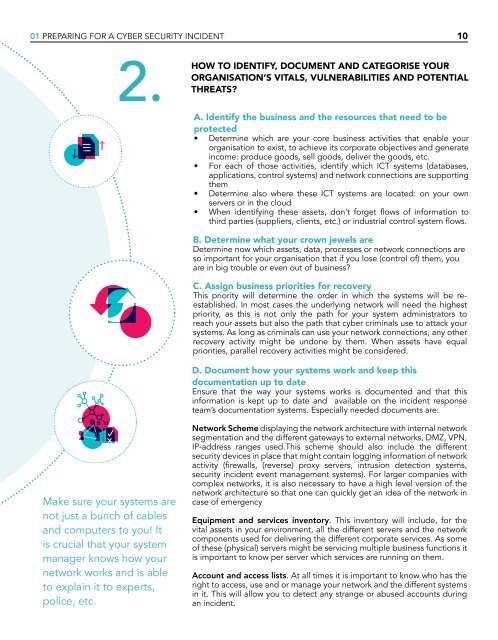CYBER SECURITY INCIDENT MANAGEMENT GUIDE
Cyber-Security-Incident-Management-Guide-2015
Cyber-Security-Incident-Management-Guide-2015
Create successful ePaper yourself
Turn your PDF publications into a flip-book with our unique Google optimized e-Paper software.
01 PREPARING FOR A <strong>CYBER</strong> <strong>SECURITY</strong> <strong>INCIDENT</strong> 10<br />
2.<br />
HOW TO IDENTIFY, DOCUMENT AND CATEGORISE YOUR<br />
ORGANISATION’S VITALS, VULNERABILITIES AND POTENTIAL<br />
THREATS?<br />
A. Identify the business and the resources that need to be<br />
protected<br />
• Determine which are your core business activities that enable your<br />
organisation to exist, to achieve its corporate objectives and generate<br />
income: produce goods, sell goods, deliver the goods, etc.<br />
• For each of those activities, identify which ICT systems (databases,<br />
applications, control systems) and network connections are supporting<br />
them<br />
• Determine also where these ICT systems are located: on your own<br />
servers or in the cloud<br />
• When identifying these assets, don’t forget flows of information to<br />
third parties (suppliers, clients, etc.) or industrial control system flows.<br />
B. Determine what your crown jewels are<br />
Determine now which assets, data, processes or network connections are<br />
so important for your organisation that if you lose (control of) them, you<br />
are in big trouble or even out of business?<br />
C. Assign business priorities for recovery<br />
This priority will determine the order in which the systems will be reestablished.<br />
In most cases the underlying network will need the highest<br />
priority, as this is not only the path for your system administrators to<br />
reach your assets but also the path that cyber criminals use to attack your<br />
systems. As long as criminals can use your network connections, any other<br />
recovery activity might be undone by them. When assets have equal<br />
priorities, parallel recovery activities might be considered.<br />
D. Document how your systems work and keep this<br />
documentation up to date<br />
Ensure that the way your systems works is documented and that this<br />
information is kept up to date and available on the incident response<br />
team’s documentation systems. Especially needed documents are:<br />
Make sure your systems are<br />
not just a bunch of cables<br />
and computers to you! It<br />
is crucial that your system<br />
manager knows how your<br />
network works and is able<br />
to explain it to experts,<br />
police, etc.<br />
Network Scheme displaying the network architecture with internal network<br />
segmentation and the different gateways to external networks, DMZ, VPN,<br />
IP-address ranges used.This scheme should also include the different<br />
security devices in place that might contain logging information of network<br />
activity (firewalls, (reverse) proxy servers, intrusion detection systems,<br />
security incident event management systems). For larger companies with<br />
complex networks, it is also necessary to have a high level version of the<br />
network architecture so that one can quickly get an idea of the network in<br />
case of emergency<br />
Equipment and services inventory. This inventory will include, for the<br />
vital assets in your environment, all the different servers and the network<br />
components used for delivering the different corporate services. As some<br />
of these (physical) servers might be servicing multiple business functions it<br />
is important to know per server which services are running on them.<br />
Account and access lists. At all times it is important to know who has the<br />
right to access, use and or manage your network and the different systems<br />
in it. This will allow you to detect any strange or abused accounts during<br />
an incident.


